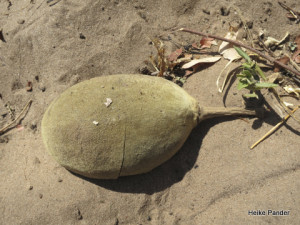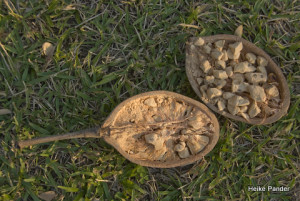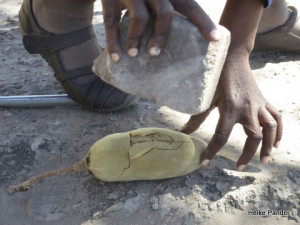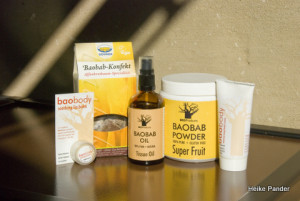High levels of antioxidants, fibers, vitamins and other essential ingredients – united in baobab superfruit! At the BioFach, the largest fair on ecological food, agriculture and eco trends worldwide, products of the baobab fruit were on display. The markets for these products are growing internationally. Local people have known about the beneficial effects of baobabs and their fruits for centuries.
Baobabs
The Baobab – its scientific name reads Adansonia digitata – is known far beyond the African continent. The celebrity impresses with its bizarre appearance and the many stories that hover around it. For some years now baobabs find their way into the news for another reason: the content of their fruit is very valuable. They are currently traded as “super fruit” or “super food” internationally – like goji berries or acai berries. Therefore it is not surprising that suppliers show their baobab products at the BioFach in Nuremberg.
Home of the Baobabs
Baobabs grow in Africa – under very special conditions. They depend on rainfall and are found in Sub Saharan Africa. The frost line determines their natural occurrence in South Africa and Namibia. The Baobab is also known as the Tree of Life or pharmacist tree because it provides valuable nutrients but also important ingredients for traditional medicine. Baobab fruit have been harvested for thousands of years in their areas of origin. The fruit was traded as far as Asia by Arab traders.
Why are baobab fruit so special?
They contain about ten times as much fiber as apples, six times as much vitamin C as oranges, six times more antioxidants than blueberries, five times as much magnesium as avocados, four times as much potassium as bananas and twice as much calcium as milk and more iron than meat – just to name a few. This unusual mix is supplemented by various B vitamins and omega fat acids. The concentration of ingredients may vary due to different soil conditions at the trees places of origin. The fruit dry on the tree, fall off when ripe and are collected from the ground by small farmers. Baobab fruit are wild collections. The trees are usually not found on plantations and therefore organic by nature. The fruit pulp tastes sour – similar to that of citrus fruit.
The fruit have a hard shell. They contain fruit pulp in which the seeds are embedded. Pulp and seeds are removed and further processed. Depending on the degree of dryness, the pulp has a creamy consistency. The baobab powder is used in soft drinks, cereals, smoothies or for cooking. The seeds contain precious baobab oil, extracted mechanically and suitable for skin care. In its countires of origin it is used to treat eczema.
Usually, pulp and seeds are processed locally and exported worldwide. Different marketing approaches are important. The providers operate in a wide spectrum, ranging from conventional trade to certification by Fairtrade or Phytotrade. If certification is sought the producers have to comply with specific criteria. For example the sustainable use of the resource, fair labor and trade relations for collectors and producers, compliance with organic standards – to name a few. This range of marketing aspects was represented at the BioFach. In addition to baobab oil and powder, soft drinks, confectionery, bread spreads and skin care products with baobab ingredients were offered at the Biofach. The following providers of baobab products exhibited at the BioFach:
www.aduna.com
www.baobab.org
www.biomega.eu
www.africrops.de
www.ecoproducts.co.za
www.mayagoldorganic.com
www.organicfriends.de
www.esse.co.za
www.amandin.com
www.planetbio.eu
www.purebeginnings.co.za
www.planetpure.com
www.lifefood.eu
www.speick.de





Thanks for the information, we love baobab as well 😀
Hi Ingo, yes they are amazing trees! Do you like the tree as such or the fruit powder and oil?